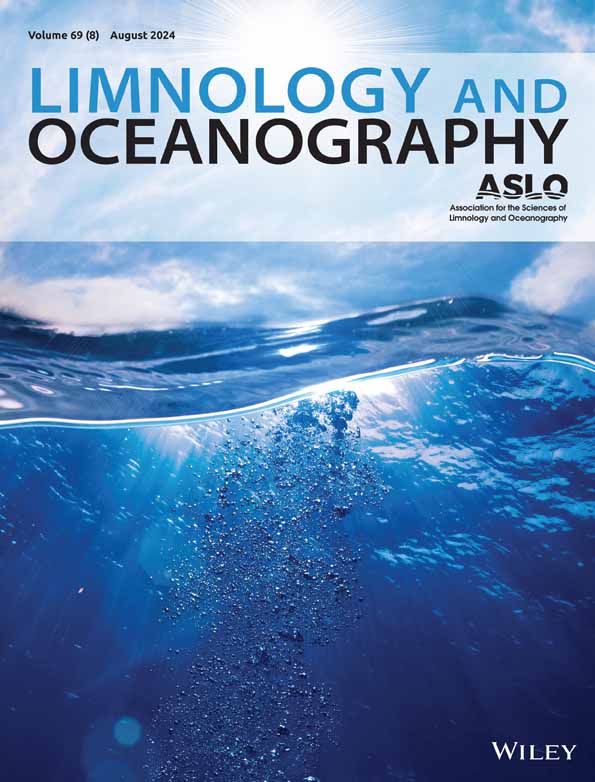新颖的全年热分层观测揭示了安大略湖独特的热混合模式
IF 3.7
1区 地球科学
Q1 LIMNOLOGY
引用次数: 0
摘要
五大湖全年的热分层记录很少,冬季的热分层观测也很少。在本文中,我们分析了13个温度记录仪链和130多个底栖声波接收器的温度数据,这些数据部署在安大略湖上2年。瀑布翻转的时间和持续时间与当地平均水深相关,浅点(50米深)比深点(100米深)早一个月。同样,在春天,浅水区变暖得更快。安大略湖部分被冰覆盖,因此整个冬季风驱动的混合搅动着水柱,而逆热分层在很大程度上不存在。深度平均冬季水温在0°C到4°C之间变化,最冷的温度(接近0.1°C)出现在金斯顿盆地浅层,最温暖的温度(接近4°C)出现在深244米的罗切斯特盆地附近。安大略湖似乎是一个温暖的单组分湖泊,而不是像前面描述的那样具有二组分混合模式——没有持续的冰盖或反分层,在冬季抑制垂直混合。对于许多水生过程,包括鱼类生物能量学、鱼类分布、生化过程、无脊椎动物分布和生产,冬季是一个知之甚少的季节。此外,冬季知识的缺乏阻碍了使用正确的初始条件来运行大型湖泊水动力模型。本文章由计算机程序翻译,如有差异,请以英文原文为准。
Unique thermal mixing patterns in Lake Ontario revealed by novel year‐round observations of thermal stratification
Year‐round records of thermal stratification in the Great Lakes are rare, and there are few observations of thermal stratification during winter. In this paper, we analyze temperature data from 13 temperature logger chains and from over 130 benthic acoustic receivers that were deployed across Lake Ontario for 2 yr. The timing and duration of the fall overturn correlate with the local average water depth, and shallow sites (< 50 m depth) overturn up to a month before deep sites (> 100 m depths). Likewise, in spring, the shallow sites warm faster. Lake Ontario has partial ice cover, so wind‐driven mixing stirs the water column throughout winter, and inverse thermal stratification is largely absent. The depth‐averaged winter water temperatures vary between 0°C and 4°C, with the coldest temperatures (near 0.1°C) found in the shallow Kingston basin and warmest temperatures (near 4°C) at sites near the 244 m deep Rochester Basin. Lake Ontario appears to be a warm monomictic lake, rather than having a dimictic mixing pattern as previously described—there is no sustained ice cover or inverse stratification that inhibits vertical mixing in winter. Winter is a poorly understood season for many aquatic processes, including fish bioenergetics, fish distribution, biochemical processes, invertebrate distribution, and production. Moreover, the lack of knowledge of winter has hampered the use of correct initial conditions for running large lake hydrodynamic models.
求助全文
通过发布文献求助,成功后即可免费获取论文全文。
去求助
来源期刊

Limnology and Oceanography
地学-海洋学
CiteScore
8.80
自引率
6.70%
发文量
254
审稿时长
3 months
期刊介绍:
Limnology and Oceanography (L&O; print ISSN 0024-3590, online ISSN 1939-5590) publishes original articles, including scholarly reviews, about all aspects of limnology and oceanography. The journal''s unifying theme is the understanding of aquatic systems. Submissions are judged on the originality of their data, interpretations, and ideas, and on the degree to which they can be generalized beyond the particular aquatic system examined. Laboratory and modeling studies must demonstrate relevance to field environments; typically this means that they are bolstered by substantial "real-world" data. Few purely theoretical or purely empirical papers are accepted for review.
 求助内容:
求助内容: 应助结果提醒方式:
应助结果提醒方式:


